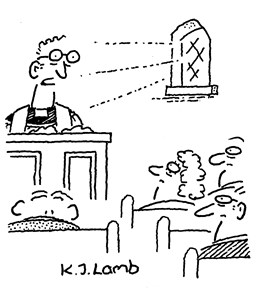A COUPLE who live in the old vicarage next to St George’s, Brailes, in Warwickshire have received a “threatening letter” stating that the 250-year-old sycamore tree on their property has caused damage and must be chopped down.
The couple, Richard and Melanie Gray, say that the letter, sent by insurers on behalf of the diocese of Coventry, asks them to chop down the tree which borders the new vicarage, or pay £69,768.88 plus VAT for a root barrier. The letter states that the sycamore’s roots have caused subsidence to the new vicarage.
The pair, who are in their seventies, are now in a dispute with legal agents acting on behalf of the diocese’s insurers. Mr Gray told the Oxford Mail that there had “been no knock at the door or anyone coming around to talk about this. The vicar hasn’t shown his face and is yet to say anything. . . I care about the tree. It’s absolutely splendid.”
 “From tiny acorns, mighty oaks grow’’ — preferably without causing subsidence
“From tiny acorns, mighty oaks grow’’ — preferably without causing subsidence
The sycamore — named the Four Shire Tree after the Four Shire Stone near by that marks the borders of Oxfordshire, Warwickshire, Worcestershire, and Gloucestershire — is 15 metres (49 ft) from both the Grays’ property and the new vicarage. The tree is unusual in that it has four trunks and was the “centre of the [original] vicarage garden”.
In the early 1980s, Coventry diocese divided the plot of land and sold the old vicarage, which dates back to the 1700s, and its remaining garden into private ownership. A new vicarage was then built on the subdivided plot. The couple, who are separated but remain close friends, are the second people to own the old vicarage privately.
Mr Gray, a retired inventor, said that the tree had been a selling point for potential buyers when he and his wife bought their home in 1982.
“Here’s an organisation which is supposed to have pastoral care and love thy neighbour, and then they say ‘take this tree down or we’ll charge you £70,000.’ To have a threatening letter sent out of the blue by the church doesn’t seem to fit into their Christian ethos. . . And then there’s the environmental impact too.”
Mr Gray believes that the damaged walls in the new vicarage are because of a burst mains pipe which flooded the property with 13,000 gallons of water daily for three days — not the sycamore tree. “Our house has been there for 200-odd years and it has no damage at all. It’s a stable part of a stable environment.” The new vicarage had, he said, been “relatively unoccupied since 2016 . . . there’s nobody living in it.”
A spokesman for the diocese of Coventry said: “St George’s church is an active and positive member of the community in Lower Brailes, and the Vicar and other members of the congregation are not involved in handling the claim. In accordance with usual practice, this claim has been referred to our insurers who are obliged to investigate, handle and deal with the claim on the Board’s behalf.
“No previous correspondence had been sent by the parish, the Coventry Diocesan Board of Finance or any other part of the diocese. However, the diocese have now opened a direct line of communication with Mr Gray and are looking forward to finding a resolution.”
Clyde & Co, the church’s legal agents, were unable to comment on an ongoing client case.















